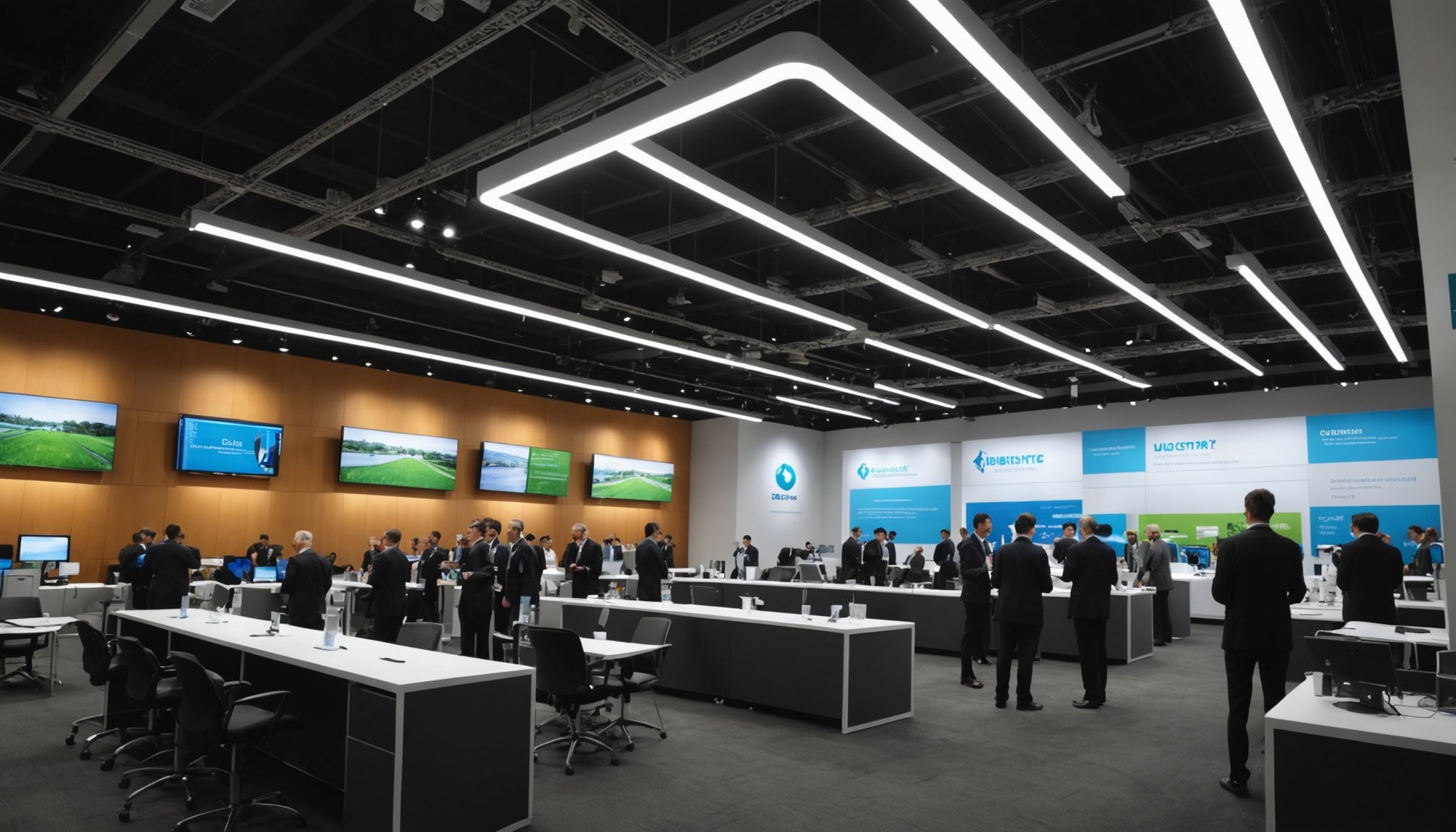Unveiling the Latest Innovations in Energy-Efficient Lighting Solutions for a Brighter Tomorrow
As we navigate the complexities of the 21st century, one thing is clear: the need for sustainable and energy-efficient solutions is more pressing than ever. One of the most significant areas where innovation is making a substantial impact is in lighting. In this article, we will delve into the latest advancements in energy-efficient lighting solutions, exploring how these technologies are shaping our future and providing practical insights for those looking to adopt these innovations.
The Evolution of Lighting Technology
Lighting has come a long way since the days of incandescent bulbs. The past few decades have seen a significant shift towards more efficient and sustainable lighting solutions. Here are some key milestones in this evolution:
Topic to read : Unveiling the impact of ai innovations on predictive policing in the uk
From Incandescent to LED
Incandescent bulbs, once the standard, are now being phased out due to their high energy consumption and short lifespan. LED (Light Emitting Diode) lights have emerged as the new gold standard. Here’s why:
- Energy Efficiency: LED lights use up to 90% less energy than incandescent bulbs and last up to 25 times longer.
- Longevity: With lifespans of up to 50,000 hours, LED lights reduce the need for frequent replacements.
- Environmental Impact: By consuming less energy, LED lights contribute significantly to reducing greenhouse gas emissions.
Smart Lighting Systems
The integration of smart technology into lighting systems is revolutionizing how we control and optimize our lighting.
Also read : Unveiling cutting-edge sustainable consumer electronics trends in the uk
- Smart Controls: Systems like those from Schneider Electric allow for real-time monitoring and adjustment of lighting levels, ensuring maximum efficiency[3].
- Automated Adjustments: Smart lighting can adjust brightness based on natural light availability, occupancy, and time of day, further optimizing energy consumption.
Innovations in LED Lighting
LED lighting is at the forefront of energy-efficient solutions, and recent innovations are making it even more appealing.
High Bay LED Lights
High bay LED lights are designed for industrial and commercial settings where high ceilings are common.
- Efficiency: These lights offer high lumen-per-watt efficiency, making them ideal for large spaces.
- Durability: Built to withstand harsh environments, high bay LED lights are a reliable choice for industrial lighting.
LED Street Lights
Municipalities around the world are transitioning to LED street lights due to their numerous benefits.
- Energy Savings: LED street lights can reduce energy consumption by up to 70% compared to traditional sodium vapor lights.
- Improved Safety: With better light distribution and color rendering, LED street lights enhance visibility and safety.
Solar-Powered LED Lights
The integration of solar power with LED lighting is a game-changer for off-grid and sustainable lighting solutions.
- Renewable Energy: Solar panels charge batteries during the day, powering LED lights at night, making them perfect for remote or eco-friendly installations.
- Cost-Effective: While the initial investment may be higher, solar-powered LED lights save money in the long run by reducing energy bills and extending the lifespan of the lighting system.
Advanced Materials and Technologies
The development of new materials and technologies is further enhancing the efficiency and sustainability of lighting solutions.
Advanced Isolation and Reflective Materials
New materials are being used to improve the isolation and reflectivity of lighting systems.
- Reflective Materials: High-reflectivity coatings and materials are used to maximize light output while minimizing energy consumption.
- Advanced Isolation: Innovations in insulation, such as aérogel panels, help in reducing heat loss and maintaining optimal lighting conditions[1].
Smart Sensors and IoT Integration
The integration of smart sensors and IoT technology is enabling real-time monitoring and optimization of lighting systems.
- Real-Time Monitoring: Sensors can detect occupancy, natural light levels, and other factors to adjust lighting accordingly.
- IoT Connectivity: This allows for remote monitoring and control, ensuring that lighting systems are always operating at peak efficiency[3].
Practical Applications and Case Studies
Let’s look at some real-world examples of how these innovations are being implemented.
Municipal LED Street Light Projects
Cities worldwide are adopting LED street lights to reduce energy consumption and improve public safety.
- Example: A project in Lyon, France, replaced traditional street lights with LED lights, resulting in a 40% reduction in energy consumption[1].
Industrial High Bay Lighting
Industrial facilities are benefiting from high bay LED lights due to their efficiency and durability.
- Example: A manufacturing plant in the United States switched to high bay LED lights, reducing their energy consumption by 60% and extending the lifespan of their lighting system[4].
Solar-Powered Lighting in Remote Areas
Solar-powered LED lights are providing reliable lighting solutions in remote and off-grid areas.
- Example: A village in Africa implemented solar-powered LED street lights, ensuring continuous lighting without the need for grid connection.
Table: Comparing Different Lighting Solutions
Here is a comparative table highlighting the key features of different lighting solutions:
| Lighting Solution | Energy Consumption | Lifespan | Cost | Environmental Impact |
|---|---|---|---|---|
| Incandescent Bulbs | High | 1,000-2,000 hours | Low | High |
| LED Lights | Low | 25,000-50,000 hours | Medium | Low |
| High Bay LED Lights | Low | 50,000 hours | High | Low |
| Solar-Powered LED | Zero (during the day) | 25,000-50,000 hours | High | Very Low |
| Smart LED Lights | Very Low | 25,000-50,000 hours | High | Very Low |
List: Key Benefits of Energy-Efficient Lighting Solutions
Here are the key benefits of adopting energy-efficient lighting solutions:
- Reduced Energy Consumption: Energy-efficient lights consume significantly less energy than traditional options.
- Longer Lifespan: LED lights last much longer than incandescent bulbs, reducing the need for frequent replacements.
- Cost Savings: While the initial cost may be higher, energy-efficient lights save money in the long run through reduced energy bills.
- Environmental Benefits: By consuming less energy, these lights contribute to reducing greenhouse gas emissions and promoting sustainability.
- Improved Safety and Visibility: Better light distribution and color rendering enhance safety and visibility, especially in public spaces.
- Smart Controls and Automation: Smart lighting systems allow for real-time monitoring and adjustment, optimizing energy efficiency.
Quotes and Insights from Experts
- “The transition to LED lighting is not just about energy efficiency; it’s about creating a sustainable future. With the right technology, we can significantly reduce our carbon footprint and improve our quality of life,” says Dr. Maria Rodriguez, a leading expert in sustainable energy solutions.
- “Smart lighting systems are the future. They offer unparalleled efficiency and control, making them a must-have for any modern building,” notes John Smith, CEO of a leading smart lighting company. and Future Outlook
As we move forward, the importance of energy-efficient lighting solutions will only continue to grow. With advancements in LED technology, smart sensors, and renewable energy integration, the future of lighting is brighter and more sustainable than ever.
Advice for Implementing Energy-Efficient Lighting
- Assess Your Needs: Before making any changes, assess your current lighting needs and identify areas where energy-efficient solutions can make the most impact.
- Choose the Right Technology: Select lighting solutions that align with your specific needs, whether it’s high bay LED lights for industrial settings or solar-powered LED lights for off-grid areas.
- Consider Smart Controls: Invest in smart lighting systems that allow for real-time monitoring and adjustment to maximize efficiency.
- Look for Incentives: Many governments and organizations offer incentives for adopting energy-efficient lighting solutions, so be sure to explore these options.
In conclusion, the latest innovations in energy-efficient lighting solutions are not just a trend; they are a necessity for building a sustainable future. By embracing these technologies, we can reduce our energy consumption, lower our environmental impact, and create a brighter, more efficient world for generations to come.











